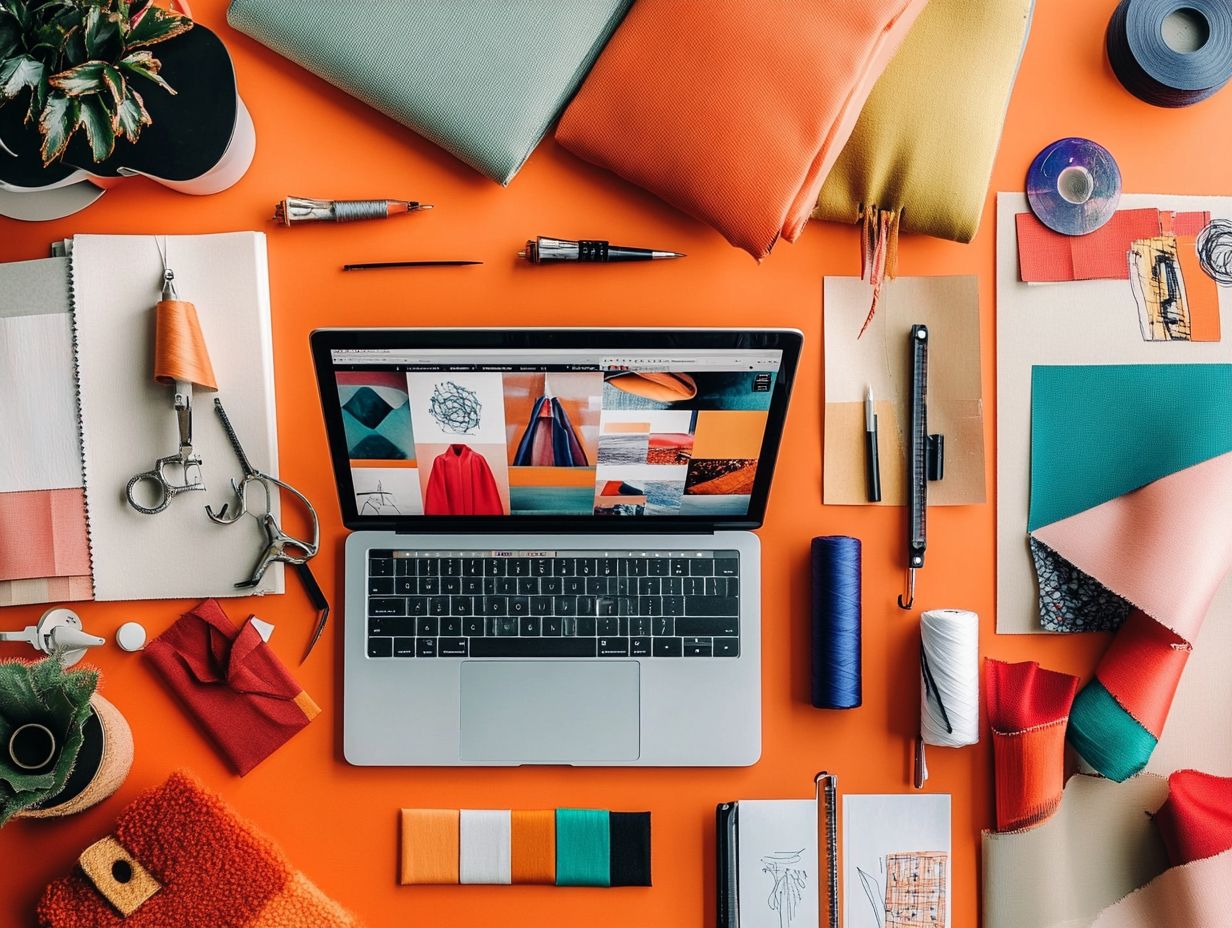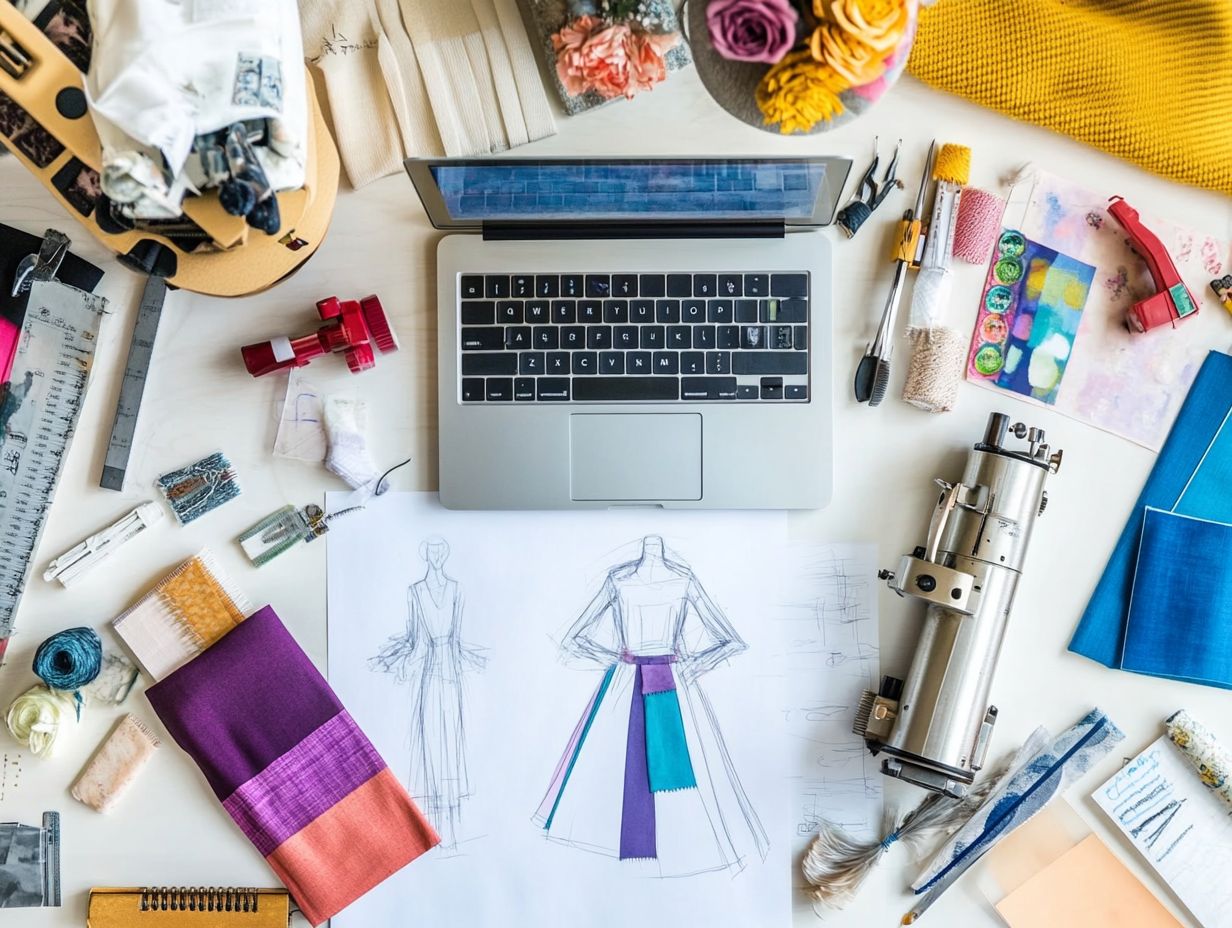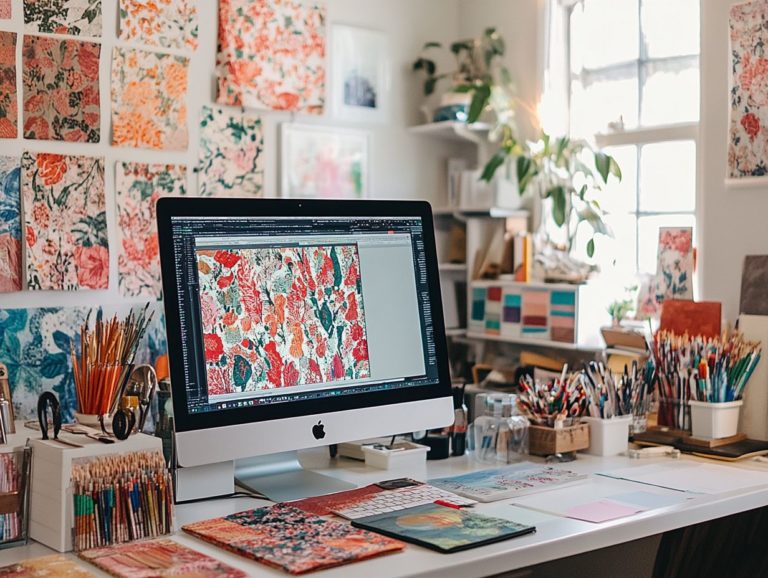Best Online Courses in Fashion Design
Fashion design is a dynamic and ever-evolving field that seamlessly blends creativity with functionality.
This guide covers everything you need to know, from fundamental design principles and color theory to the rich history of fashion and essential skills like garment construction and textile knowledge.
Each section reveals important information, diving into the fashion business, sustainable practices, and various specialization options.
Equip yourself with the knowledge to thrive in this vibrant industry and ignite your passion for fashion!
Contents
- Key Takeaways:
- 2. Fashion Design Basics
- 3. History of Fashion
- 4. Elements and Principles of Design
- 5. Color Theory in Fashion
- 6. Drawing and Sketching Techniques
- 7. Fabric Selection and Textile Knowledge
- 8. Garment Construction and Sewing Techniques
- 9. Pattern Making and Draping
- 10. Fashion Illustration and Digital Design
- 11. Fashion Business and Marketing
- 12. Sustainable Fashion Practices
- 13. Specialization in Men’s Wear, Women’s Wear, or Children’s Wear
- 14. Portfolio Development and Presentation
- 15. Internship or Work Experience Opportunities
- Frequently Asked Questions
- What should I consider when choosing an online fashion design course?
- Are there any highly recommended online courses in fashion design that stand out?
- How can I ensure that the online course I choose will provide a quality education in fashion design?
- Are there any free online courses in fashion design that are worth taking?
- Can online courses in fashion design provide the same level of education as traditional in-person courses?
- What are some potential career opportunities for those who complete the best online courses in fashion design?
Key Takeaways:

Unlock the secrets of fashion design fundamentals, including history, principles, and color theory, to lay a strong foundation for your creative journey.
Gain hands-on experience in garment construction, pattern making, and draping techniques, which involve arranging fabric on a dress form to create a garment design, to bring your designs to life with professional-level skills.
Specialize in a specific area of fashion, such as menswear, womenswear, or childrenswear, and develop a strong portfolio to showcase your unique style and vision in the industry.
2. Fashion Design Basics
Understanding the basics of fashion design is essential for anyone who wants to transition from sketch to style. These foundational skills provide the groundwork for creating unique garments that resonate with your personal aesthetics and the latest trends.
Start your exciting journey with the art of sketching! You ll learn to translate your visions onto paper, bringing your imaginative concepts to life.
Next, careful fabric selection plays a crucial role in shaping the overall feel and functionality of your designs. This allows you to experiment with textures and colors that evoke emotion and tell a compelling story.
Mastering garment construction is essential. It ensures that your final piece not only looks visually stunning but also fits and functions beautifully.
By honing these essential skills, you can confidently navigate the creative landscape, transforming your ideas into tangible expressions of style.
3. History of Fashion
The history of fashion unfolds as a captivating narrative intricately intertwined with societal evolution. Each era shapes the fashion landscape and influences the work of renowned designers, reflecting the cultural trends and values of its time.
Consider the opulent styles of the Baroque period, where extravagant garments adorned with intricate details reigned supreme. Then, think of the revolutionary impact of the 1920s flapper movement, a pivotal moment that redefined aesthetics.
Influential designers like Coco Chanel, who liberated women from the confines of corsets, and Christian Dior, whose ‘New Look’ in the post-war years celebrated femininity, have left an indelible mark on this evolution.
Today, you can still feel the echoes of these historical movements as modern design practices draw inspiration from past innovations. It s a beautiful fusion of classic elements and contemporary styles, all tailored to resonate with current fashion trends.
4. Elements and Principles of Design
The elements and principles of design are the foundation of your fashion journey. They guide you in crafting a cohesive collection that harmonizes components like color, shape, and texture while showcasing your unique talents.
This foundational framework establishes a visual language that resonates with your audience. For instance, using line can create a sense of movement, directing the viewer’s eye through your collection.
Shape contributes to the overall silhouette and form of your garments, while color plays a vital role in conveying mood and emotion, often mirroring current trends or seasonal palettes.
Texture adds depth and interest, enhancing the tactile experience of your clothing.
Successful collections, much like those from iconic designers, effectively demonstrate these principles by integrating:
- Balance ensuring that no single element overpowers the rest;
- Contrast to highlight specific features;
- Emphasis to draw attention to key pieces, making your collection both memorable and impactful.
5. Color Theory in Fashion
Color theory is essential in fashion design. It helps you understand the psychology behind colors and their combinations.
This knowledge gives you the power to create visually captivating pieces that align with current trends.
With this understanding, you can select color palettes that reflect the mood of your collection.
For instance, using complementary colors creates a bold contrast that commands attention, while analogous colors foster harmony.
As a designer, you ll also want to consider how specific hues can shape perceptions of form and fit, influencing how your creations are received by your audience.
By masterfully applying these color principles, you craft a narrative and steer the viewer s emotions, making color one of the most potent tools in your creative toolkit.
6. Drawing and Sketching Techniques

Mastering drawing and sketching techniques is essential for you as a fashion designer.
These skills are your primary means of translating creative ideas into visual representations that can evolve into stunning fashion illustrations and garments.
From capturing the human form in figure drawing to creating detailed garment sketches, each method plays a vital role in your design process.
Figure drawing helps you understand proportions and movement, which is crucial for understanding how fabric drapes on the body.
Garment sketches breathe life into your ideas with color and texture, while technical flats make sure construction details are clear for production.
Practice regularly and experiment with different styles to refine your techniques and cultivate a unique artistic voice that sets your work apart.
7. Fabric Selection and Textile Knowledge
Your understanding of fabric selection and textiles is vital in fashion design. The right materials can elevate a concept into a stunning garment that catches the eye and fulfills practical needs.
Each fabric has unique characteristics that affect how it drapes, stretches, and wears.
For instance, breathable cotton is ideal for laid-back summer looks, while luxurious silk adds an elegant flair perfect for evening attire.
Knowing the structural qualities of fabrics like weight and resilience directly influences how you construct garments, ensuring they are both durable and comfortable.
Familiarize yourself with these properties to make informed choices, leading to creations that appeal aesthetically and function beautifully in everyday life.
This understanding ultimately enhances the overall success of your fashion collection.
8. Garment Construction and Sewing Techniques
Garment construction and sewing techniques serve as the foundation of fashion design, equipping you with the vital skills needed to transform your sketches into exquisite fashion pieces.
For you, as an aspiring designer, mastering these skills is absolutely essential for breathing life into your creative visions.
Various methods, such as machine and hand stitching, play a critical role in ensuring both durability and aesthetic appeal.
Techniques like finishing seams and hems enhance the overall polish of your garments, while a solid understanding of fit is crucial for comfort and wearability.
Grasp these fundamentals now to innovate and stand out in the fashion world!
9. Pattern Making and Draping
Pattern making and draping are essential processes in fashion design, empowering you to create unique silhouettes and ensure that garments fit flawlessly while seamlessly integrating into the overall construction of each piece.
These techniques form the backbone of your creative journey, empowering you to experiment with various shapes and structures before finalizing your designs.
For instance, when you drape fabric directly on a dress form, you engage in an organic exploration of how materials fall and move. This tactile approach often yields unexpected design variations that a flat pattern simply cannot provide.
Pattern making delivers the blueprint from which your garments come to life, helping you refine crucial details such as darts, seams, and contours that guarantee a comfortable fit.
Together, these methods not only cultivate a tailored appearance but also inspire innovative styles, enhancing your artistic expression in every piece you create!
10. Fashion Illustration and Digital Design
Fashion illustration and digital design are your modern allies, empowering you to bring your creative visions to life. They provide a dynamic playground where your ideas can be visualized and refined long before they hit the production floor.
Over the years, the art of fashion illustration has evolved dramatically, shifting from hand-drawn sketches on paper to sophisticated digital platforms that allow for real-time edits and enhancements.
You now have at your disposal advanced software like Adobe Illustrator and Procreate, which not only streamline your creative process but also enable you to seamlessly integrate vibrant color palettes and intricate patterns.
These digital tools invite you to explore styles dynamically, allowing for experimentation with textures and shading like never before!
The rise of online sharing platforms has revolutionized how you showcase your concepts, making it easier to gather feedback and collaborate with creatives around the globe. This enriches your overall design journey.
11. Fashion Business and Marketing

Understanding the principles of fashion business and marketing is crucial for you as a designer if you want to thrive in the competitive fashion landscape, where branding, consumer engagement, and market trends dictate success.
By mastering these essential concepts, craft compelling brand identities that resonate with your target audience. Conduct thorough market analysis to identify emerging trends and consumer preferences, allowing you to align your collections with what buyers genuinely desire.
Implement effective promotional strategies whether through social media campaigns or influencer partnerships to significantly enhance your visibility and impact.
When you integrate these elements thoughtfully, you establish a solid presence and foster long-term relationships with customers. This approach opens doors to a thriving career in fashion!
12. Sustainable Fashion Practices
Sustainable fashion practices are becoming increasingly vital in the fashion industry. Designers are crafting innovative solutions that minimize environmental impact while upholding style and quality in tune with current trends.
To strike this delicate balance, many designers are turning to eco-friendly materials like organic cotton, recycled polyester, and biodegradable fabrics, all aimed at reducing waste and lowering carbon footprints.
Ethical production methods are equally crucial, ensuring fair wages and safe working conditions for everyone involved in the garment-making process.
The importance of consumer education cannot be overstated; when you re informed about the implications of your choices, you can make more conscious decisions.
By integrating these sustainable practices into your creative vision, you not only set new standards for fashion but also inspire a movement toward a more responsible industry. Join the movement toward responsible fashion today!
13. Specialization in Men’s Wear, Women’s Wear, or Children’s Wear
Specializing in men’s wear, women’s wear, or children’s wear allows you, as a fashion designer, to channel your talents and creativity into specific segments of the fashion market.
This approach enables you to tailor your skills to meet the unique needs and preferences of diverse consumer groups.
By adopting this focused strategy, you cultivate expertise in design while developing a keen understanding of market demands that can vary significantly across different demographics.
For instance, men’s wear often prioritizes functionality and tailored fits. Women’s wear may draw inspiration from contemporary trends and diverse silhouettes to cater to a wide array of occasions.
Children’s wear, however, presents its own challenges. You must balance durability with playful aesthetics, keeping in mind the rapid growth and energetic nature of children.
Successful designers like Giorgio Armani in men’s wear and Stella McCartney in women’s wear demonstrate how to navigate these complexities while remaining attuned to evolving consumer behaviors.
Their ability to create remarkable collections that resonate deeply with their target audiences serves as a testament to the power of specialization in the fashion industry.
14. Portfolio Development and Presentation
A well-curated portfolio is your essential tool as a fashion designer. It serves as a visual representation of your capabilities and creative journey while effectively showcasing your skills to potential employers and clients.
This compilation isn t just a collection of your work; it s a narrative that reflects your unique style and technical skills. To make it truly stand out, incorporate key elements such as:
- Detailed sketches that illustrate your conceptual phase,
- High-quality photographs of finished garments that reveal your craftsmanship,
- Comprehensive project descriptions that explain the thought process behind each piece.
To enhance the impact of your portfolio, consider thoughtful presentation techniques. Cohesive layouts, color themes that resonate with your individual aesthetics, and engaging storytelling will help connect your various works to a compelling narrative or inspiration.
15. Internship or Work Experience Opportunities
Internships are a game changer for aspiring designers! They provide practical exposure to the fashion industry and allow you to apply your skills in real-world settings.
These experiences enhance your portfolio and facilitate essential networking connections that can pave the way for future job opportunities.
Engaging in internships gives you hands-on experience that sharpens your technical skills while helping you grasp industry trends and consumer preferences.
To uncover such opportunities, leverage online platforms like LinkedIn, connect with professionals at fashion events, and reach out to educational institutions for available programs.
Craft a tailored resume and cover letter that showcases your relevant experiences to significantly boost your chances during the application process.
Frequently Asked Questions

What should I consider when choosing an online fashion design course?
When choosing the best online course in fashion design, consider factors such as the course curriculum, the reputation and credentials of the instructors, the flexibility and accessibility of the course, and any additional resources or support offered.
Are there any highly recommended online courses in fashion design that stand out?
Yes, several highly recommended online courses in textile design stand out, including those offered by top fashion schools like Parsons School of Design and Central Saint Martins, as well as those taught by renowned fashion designers like Marc Jacobs and Diane von Furstenberg.
How can I ensure that the online course I choose will provide a quality education in fashion design?
One way to ensure that the online course you choose will provide a quality education in fashion design is to research the course thoroughly, read reviews from past students, and inquire about the credentials and experience of the instructors. Look for courses offering industry recognition or accreditation.
Explore available online courses today and kickstart your fashion design journey!
Are there any free online courses in fashion design that are worth taking?
Yes, there are several free online courses in fashion design that are worth taking. These are offered by fashion schools, magazines, and platforms like Coursera and edX.
Can online courses in fashion design provide the same level of education as traditional in-person courses?
Online courses in fashion design can match the quality of traditional classes. However, this depends on the course’s reputation and the dedication of the student.
What are some potential career opportunities for those who complete the best online courses in fashion design?
Completing top online courses in fashion design can lead to various careers. Opportunities include fashion designer, buyer, merchandiser, stylist, and marketing specialist. Don t miss out on your chance to kickstart your career in fashion! Enroll in a top online course today!






